否定句型翻译
- 格式:rtf
- 大小:149.42 KB
- 文档页数:1

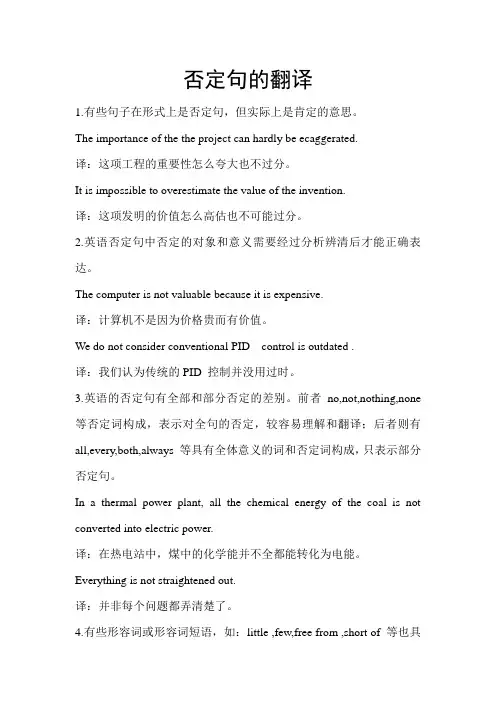
否定句的翻译1.有些句子在形式上是否定句,但实际上是肯定的意思。
The importance of the the project can hardly be ecaggerated.译:这项工程的重要性怎么夸大也不过分。
It is impossible to overestimate the value of the invention.译:这项发明的价值怎么高估也不可能过分。
2.英语否定句中否定的对象和意义需要经过分析辨清后才能正确表达。
The computer is not valuable because it is expensive.译:计算机不是因为价格贵而有价值。
We do not consider conventional PID control is outdated .译:我们认为传统的PID 控制并没用过时。
3.英语的否定句有全部和部分否定的差别。
前者no,not,nothing,none 等否定词构成,表示对全句的否定,较容易理解和翻译;后者则有all,every,both,always 等具有全体意义的词和否定词构成,只表示部分否定句。
In a thermal power plant, all the chemical energy of the coal is not converted into electric power.译:在热电站中,煤中的化学能并不全都能转化为电能。
Everything is not straightened out.译:并非每个问题都弄清楚了。
4.有些形容词或形容词短语,如:little ,few,free from ,short of 等也具有否定意义,翻译是应突出其否定的语气。
尤其注意区分little 和a little ,few和a few 的差别:little和few 通常表示否定,二a little 和a few 这通常表示可定。
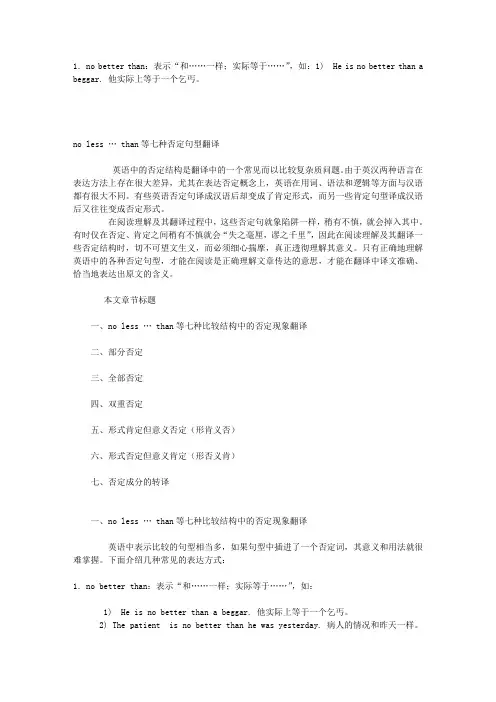
1.no better than:表示“和……一样;实际等于……”,如:1) He is no better than a beggar. 他实际上等于一个乞丐。
no less … than等七种否定句型翻译英语中的否定结构是翻译中的一个常见而以比较复杂质问题。
由于英汉两种语言在表达方法上存在很大差异,尤其在表达否定概念上,英语在用词、语法和逻辑等方面与汉语都有很大不同。
有些英语否定句译成汉语后却变成了肯定形式,而另一些肯定句型译成汉语后又往往变成否定形式。
在阅读理解及其翻译过程中,这些否定句就象陷阱一样,稍有不慎,就会掉入其中。
有时仅在否定、肯定之间稍有不慎就会“失之毫厘,谬之千里”,因此在阅读理解及其翻译一些否定结构时,切不可望文生义,而必须细心揣摩,真正透彻理解其意义。
只有正确地理解英语中的各种否定句型,才能在阅读是正确理解文章传达的意思,才能在翻译中译文准确、恰当地表达出原文的含义。
本文章节标题一、no less … than等七种比较结构中的否定现象翻译二、部分否定三、全部否定四、双重否定五、形式肯定但意义否定(形肯义否)六、形式否定但意义肯定(形否义肯)七、否定成分的转译一、no less … than等七种比较结构中的否定现象翻译英语中表示比较的句型相当多,如果句型中插进了一个否定词,其意义和用法就很难掌握。
下面介绍几种常见的表达方式:1.no better than:表示“和……一样;实际等于……”,如:1) He is no better than a beggar. 他实际上等于一个乞丐。
2) The patient is no better than he was yesterday. 病人的情况和昨天一样。
3) He has no better a say in the matter than I have.他和我一样在这件事上没有发言权。
2.not. . . any more than或no more. . . than:表示“同……一样不”,如:1) I could no more do that than you. I could not do that any more than you. 你不能做这件事,我也不能做。

否定句翻译Negative Sentencesa.not...to do...结构They do not conduct the dangerous experiment to serve their private interest but to benefit man.误: 为了他们的利益,也为了人类的利益,他们没有进行这种危险的实验。
正:他们进行这种危险的实验不是为了图私利,而是为了造福人类。
People did not shake off colonialist?s yoke [ j?uk ] 支配in order to put on hegemonist?s[ hi'gem?nist] .误: 人们没有摆脱殖民主义的束缚,是为了套上霸权主义的枷锁。
正:人们摆脱殖民主义的束缚,不是为了套上霸权主义的枷锁。
b.not...because (of )...结构We should not scamp [ sk?mp ] 大意our work because we are pressed for time or because we have our hands full.误: 我们对工作不能马马虎虎,因为我们时间很紧,工作太忙。
正:我们可不能因为时间太紧或工作太忙就对工作马马虎虎。
The seed does not complain because there are stones and turf [ t?:f ]草皮in way.误: 种子没有抱怨,因为在它的道路上有石头和草皮。
正:种子并不因为有石头和草皮挡住它的路而抱怨。
Conclusion否定转移:将意义上属于从句、次干结构(状语)的否定词转移到主句或主要动词之上。
1. 将think, believe, suppose, expect, fancy, imagine等动词后面宾语从句的否定词转移到主句中,即主句的谓语动词用否定式,而从句的谓语动词用肯定式。
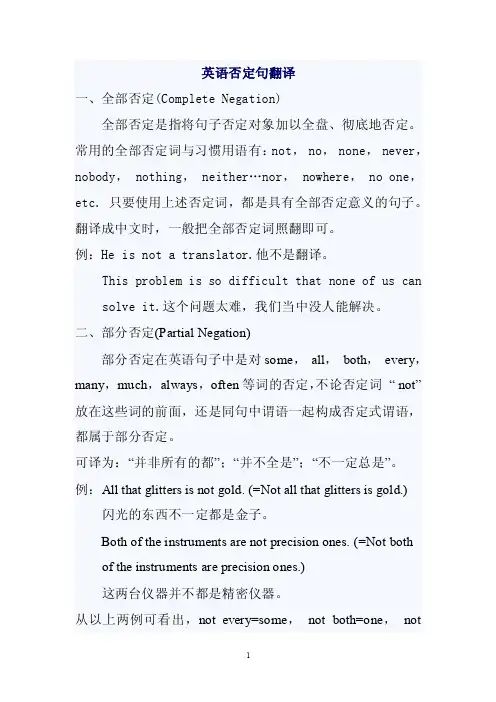
英语否定句翻译一、全部否定(Complete Negation)全部否定是指将句子否定对象加以全盘、彻底地否定。
常用的全部否定词与习惯用语有:not, no, none, never,nobody, nothing,neither…nor, nowhere, no one,etc. 只要使用上述否定词,都是具有全部否定意义的句子。
翻译成中文时,一般把全部否定词照翻即可。
例:He is not a translator.他不是翻译。
This problem is so difficult that none of us can solve it.这个问题太难,我们当中没人能解决。
二、部分否定(Partial Negation)部分否定在英语句子中是对some,all,both,every,many,much,always,often等词的否定,不论否定词“ not”放在这些词的前面,还是同句中谓语一起构成否定式谓语,都属于部分否定。
可译为:“并非所有的都”;“并不全是”;“不一定总是”。
例:All that glitters is not gold. (=Not all that glitters is gold.) 闪光的东西不一定都是金子。
Both of the instruments are not precision ones. (=Not bothof the instruments are precision ones.)这两台仪器并不都是精密仪器。
从以上两例可看出,not every=some,not both=one,notalways=sometimes,not wholly=in some degree not together=somewhat.三、双重否定(Double Negation)双重否定是指两个否定词并用,否定同一个单词,或者一个否定词否定另一个否定词,其否定意义互相抵消得到肯定意义。

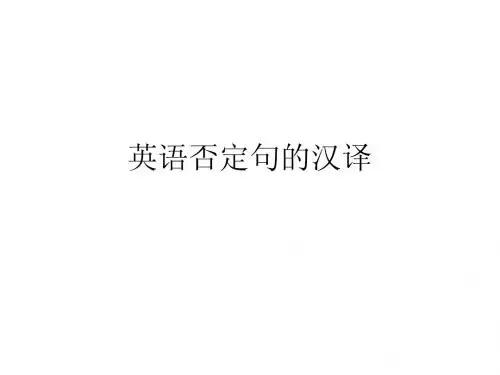

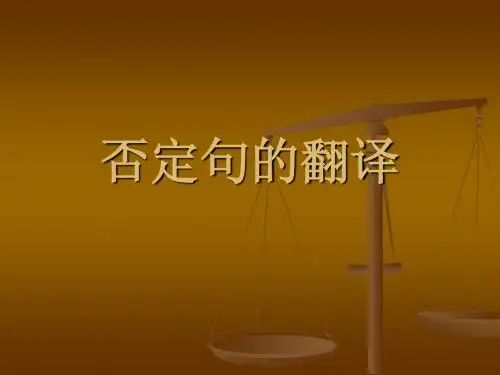
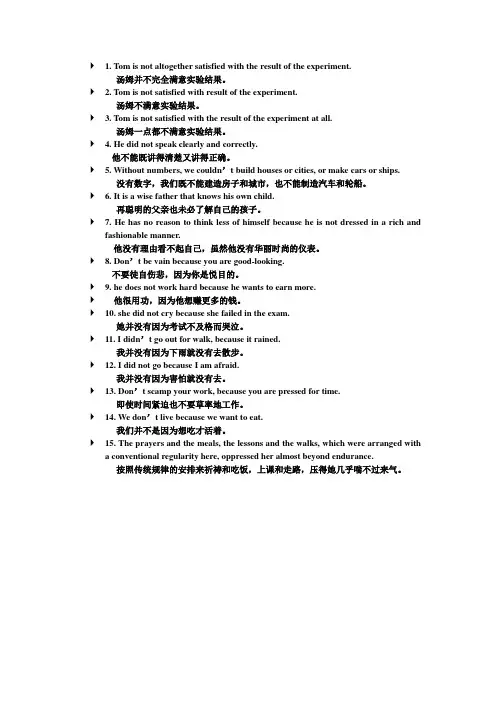
❝ 1. T om is not altogether satisfied with the result of the experiment.汤姆并不完全满意实验结果。
❝ 2. T om is not satisfied with result of the experiment.汤姆不满意实验结果。
❝ 3. T om is not satisfied with the result of the experiment at all.汤姆一点都不满意实验结果。
❝ 4. He did not speak clearly and correctly.他不能既讲得清楚又讲得正确。
❝ 5. Without numbers, we couldn’t build houses or cities, or make cars or ships.没有数字,我们既不能建造房子和城市,也不能制造汽车和轮船。
❝ 6. It is a wise father that knows his own child.再聪明的父亲也未必了解自己的孩子。
❝7. He has no reason to think less of himself because he is not dressed in a rich and fashionable manner.他没有理由看不起自己,虽然他没有华丽时尚的仪表。
❝8. Don’t be vain because you are good-looking.不要徒自伤悲,因为你是悦目的。
❝9. he does not work hard because he wants to earn more.❝他很用功,因为他想赚更多的钱。
❝10. she did not cry because she failed in the exam.她并没有因为考试不及格而哭泣。
❝11. I didn’t go out for walk, because it rained.我并没有因为下雨就没有去散步。
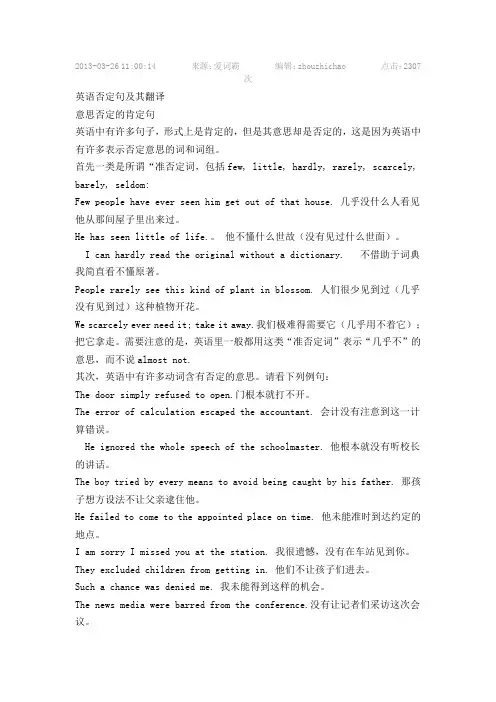
2013-03-26 11:00:14 来源:爱词霸编辑:zhouzhichao 点击:2307次英语否定句及其翻译意思否定的肯定句英语中有许多句子,形式上是肯定的,但是其意思却是否定的,这是因为英语中有许多表示否定意思的词和词组。
首先一类是所谓“准否定词,包括few, little, hardly, rarely, scarcely, barely, seldom:Few people have ever seen him get out of that house. 几乎没什么人看见他从那间屋子里出来过。
He has seen little of life.。
他不懂什么世故(没有见过什么世面)。
I can hardly read the original without a dictionary. 不借助于词典我简直看不懂原著。
People rarely see this kind of plant in blossom. 人们很少见到过(几乎没有见到过)这种植物开花。
We scarcely ever need it; take it away.我们极难得需要它(几乎用不着它);把它拿走。
需要注意的是,英语里一般都用这类“准否定词”表示“几乎不”的意思,而不说almost not.其次,英语中有许多动词含有否定的意思。
请看下列例句:The door simply refused to open.门根本就打不开。
The error of calculation escaped the accountant. 会计没有注意到这一计算错误。
He ignored the whole speech of the schoolmaster. 他根本就没有听校长的讲话。
The boy tried by every means to avoid being caught by his father. 那孩子想方设法不让父亲逮住他。
If you had come to my place, I would have told you about it.如果你那时到我这儿来,我是会告诉你的。
(这句话表示事实上的否定,意为“你没有到我这儿来,我也没有告诉你。
”It seemed as if he were trying to teach us all he knew in one class.看起来他好像想把自己所有的知识在一堂课内都教给我们。
(事实上,不可能将所有的知识在一堂课内教授)If only 与过去完成时连用时,表示同过去事实相反的主观设想,同样含有否定的意味,通常翻译成“要是……该多好啊”。
If only you had worked with great care! 你要是更仔细一些该多好啊!If only you had told me before. 要是你早告诉我就好了。
If only he hadn’t driven so fast.他没把车子开得这么快就好了。
8. 介词表示否定英语中介词的使用是相当活跃的,其中有些介词同样表达否定的意义,如from, off, of, in, without, for, above, beyond, past, out of, against, beside, 等等。
He is against the plan. 他反对这个计划。
He is out of work. 他失业了。
Good advice is above/ beyond/ without price. 好的建议是无价的。
This strange idea is beyond belief. 这种奇怪的想法令人难以置信。
I can see nothing without my glasses. 不戴眼镜我什么都看不见。
She is still in two minds. 她还没拿定主意。
I am off duty today. 我今天不值日。
否定形式和比较形式的翻译:否定形式:带有否定词的句子不容易译对,这是因为有的否定是隐形的,不容易看出来;有的是由于否定范围不容易确定等。
Not….. as/like1.The number of people who consult psychiatrists today is not, as issometimes felt, a symptom of increasing mental ill healthy.2.今天这么多人去找精神病医生咨询,并不像人们常常感到的那样说明了精神病患者的日益增多。
3.人们常常觉得,今天这么多人去找精神病医生咨询,并不表明精神病患者的日益增多。
4.Spiders are not insects, as many people think, nor even nearly relatedto them.5.蜘蛛并不像许多人认为的那样属于昆虫,它们甚至和昆虫一点关系都没有6.许多人认为,蜘蛛并不属于昆虫,它们甚至和昆虫一点关系都没有。
7.He does not limit his principal advisers to a special field ofconcentration like Mr. Truman.Not ……because1.But two systems are not necessarily identical, or even very similarmerely because they have some properties in common.2.Xiaoming does not like her because she is aesthetically-challenged.3.They do not conduct the dangerous experiment to serve their privateinterest.Not…. or /nearly、possibly/ nowhere1.But even he was unable to discover how long the gorilla lives, or howor why it dies, nor was he able to define the exact social pattern of the family groups, or indicate the final extent of their intelligence.2.可是就算他也未能发现大猩猩能活多久,或怎么死的,或死于什么原因,他也无法明确说明大猩猩的家族群居方式,或指出它的智力程度。
no less … than等七种否定句型翻译英语中的否定结构是翻译中的一个常见而以比较复杂质问题。
由于英汉两种语言在表达方法上存在很大差异,尤其在表达否定概念上,英语在用词、语法和逻辑等方面与汉语都有很大不同。
有些英语否定句译成汉语后却变成了肯定形式,而另一些肯定句型译成汉语后又往往变成否定形式。
在阅读理解及其翻译过程中,这些否定句就象陷阱一样,稍有不慎,就会掉入其中。
有时仅在否定、肯定之间稍有不慎就会“失之毫厘,谬之千里”,因此在阅读理解及其翻译一些否定结构时,切不可望文生义,而必须细心揣摩,真正透彻理解其意义。
只有正确地理解英语中的各种否定句型,才能在阅读是正确理解文章传达的意思,才能在翻译中译文准确、恰当地表达出原文的含义。
本文章节标题一、no less … than等七种比较结构中的否定现象翻译二、部分否定三、全部否定四、双重否定五、形式肯定但意义否定(形肯义否)六、形式否定但意义肯定(形否义肯)七、否定成分的转译一、no less … than等七种比较结构中的否定现象翻译英语中表示比较的句型相当多,如果句型中插进了一个否定词,其意义和用法就很难掌握。
下面介绍几种常见的表达方式:1.no better than:表示“和……一样;实际等于……”,如: He is no better than a beggar. 他实际上等于一个乞丐。
6.no less … than:表示“和……一样”如, He is no less active than he used to be. 他和从前一样活跃。
2. no more. . than:表“同…一样不”= not as/so...as如:This story is no more interesting than that one. (一样没)(补“莫染”:He doesn’t work harder than I.不如。
再补:①there are no 仅有/ not 至多 +“莫染”seven people in the room 。
②与其,不如:he is more diligent than clever →not as / so clever as .③ It is more like a meeting than like a party →not as a party as a meeting . ④Tom is more than my teacher , he is also my best friend .不仅,还)adj,一修饰V,且连词不同)3.“与其…不如…如与其说不,不如说4.nothing like+ n表“能比得上…”如There is nothing like home. 金银,草窝。
5.nothing like/near+as/so... as:表“远远不像……那样”如, This novel is nothing near so interesting as that one. 这篇小说远远不及那篇小说有趣。
二、部分否定英语中的所谓部分否定,是指代词或者副词如:all, both, every, everybody, everyday, everyone, many, everything, entirely, altogether, absolutely, wholly, completely, everywhere, always, often等与否定词not搭配使用。
部分否定的翻译比较简单,常常翻译为“并非所有,并不是都。
如:1.all…not(不全是,不都是),2.both…not(并非两个都,不是两者都),3.every…not(不是每个都),4.not always(不总是,不一定),5.not often(不经常),6.not altogether(不全是),7.not necessarily(未必)等。
如,并非所有发光的都是金子。
需要注意,也会置句首,如,三、全部否定在英语中,构成全部否定的单词和词组主要有以下这些:1.never(决不,从来不),2.no(没有,不),3.not(不,不是),4.none(没人,谁都不,没有任何东西),5.nobody(没人),6.nothing(什么也没有,没有任何事情),7.nowhere(没有什么地方),8.neither(两者都不),9.nor(也没有,也不),not at all (一点也不)。
如,He is no professor.他根本不是教授。
四、双重否定翻汉时,可以直接用汉语对应的双重否定来翻译,即汉语的肯定句:1.no…not(没有……不),2.without…not(没有……就不),3.never(no)…without(每逢……总是,没有……不),4.never(no)…but(没有……不),5.not(none)…the less(并不……就不),6.not(never)…unless(不少于,不亚于,和……一样),7.not…any the less(没有……而少做)。
如, 6)That’s nothing less than a miracle.那完全是一个奇迹。
五、形肯义否 (肯否)(一)more than can…结构“莫然看(否、帮)”more than can…这个结构本身是英语的肯定结构,但要翻译为汉语的否定句。
1.more than can…在意义上相当于英语的2.can not…可译为“简直不,无法,难以”;3.more than one can help相当于as little as possible,可以翻译为“尽量不,绝对不”。
如,The beauty of the park is more than words can describe.美得无法形容。
(二)anything but…结构“俺想爸”(即,根本不,一点也不”)。
如 The wood bridge is anything but safe. 一点也不安全。
(三)have yet to do…结构“还有爷to do”(即,“还没有”。
)如,I have yet to hear the story. 还没有听过那个故事。
(四)may (might) as well…结构“没爱完”(即“还不如”。
)如, 1)It is still raining hard outside; we may as well stay here over the night.(五)借助具有否定意义的动词或动词短语 V & Vphr1.miss(错过,即没有碰到),2.deny(拒绝,即没有答应),ck(缺乏,即不足),4.refuse(拒绝,即否认,没有答应),5.escape(逃避,即没有被发现),6.resist(抵抗,即没有放弃),7.reject(拒绝,即没有答应),8.decline(拒绝,即没有答应),9.doubt(怀疑,即不太确信),10.wonder(想知道,即不明白),11.fail(失败,即没有完成),exclude(排除,即没有接受,不包括),12.overlook(没有注意到),13.cease(终止,即没有坚持),14.neglect(没有注意到),15.defy(不服从),16.forbid(不许),17.give up(放弃,即没有坚持),18.refrain from(不允许),19.lose sight of(不管),20.keep up with(不落后于),21.save…from(使…不),22.shut one's eyes to(不看),23.to say nothing of(更不用说),24.not to mention(更不用说),25.protect(keep, prevent)…from(不让),26.keep off(不接近),27.keep out(不让进入),28.fail to do sth.没有能够做成某事。
29.turn a deaf ear to(不听,不顾),30.fall short of(不足),31.live up to(不辜负),32.dissuade…from(劝…不要),33.keep…dark(不把…说出去)等。
如,Please keep the news dark.请不要把这个消息说出去。
(六)借助具有否定意义的名词 Nneglect(没有注意到),failure(失败,即没有完成),refusal(拒绝,即否认,没有答应),absence(不在,缺少),shortage(不足),reluctance(不情愿),ignorance(没有注意到),loss(没有),exclusion(排除,即没有接受,不包括),lack(缺乏,没有),negation(拒绝,即否认),Greek to(对…一无所知)等等。
如, His exclusion from the club hurt him very much.(七)Adj & adj phr1.far from(远不,一点也不),2.free from(不受…影响),3.safe from(免于),4.short of(缺少,不足),5.ignorant of(不知道,没有注意到),independent of(不受…的支配),6.impatient of(对…不耐烦),7.deficient(缺乏),8.devoid of(不具有,缺乏),9.alien to(不同),10.foreign to(不适合,与…无关),11.blind to(看不见),12.far and few between(很少),13.absent from(不在),14.different from(不同),15.reluctant to(不愿意),16.less than(少于,不多于),17.dead to(对…没有反应),18.the last(最后的,即最不愿意,最不配,决不)等等。
如,He is the last man she wants to meet. (最不想见)(八)Prep & p-phr19.past(超过),20.above(不低于),21.without(没有),22.beyond(超出),23.instead of(而不是),24.in vain(无效,没有),25.in the dark(一点也不知道),26.at a loss(不知所措),27.but for(要不是),28.in spite of(不管),29.at fault(出错),30.against(不同意),31.before(还没有…就),32.below(不到…),33.beside(与…无关),34.but(除…之外),35.except(除…之外),36.from(阻止,使…不做某事),37.off(离开,中断),38.under(在…之下,不足),39.within(不超出),40.beneath(不如,不足),41.beneath one’s notice(不值得理睬),42.out of(不在…里面,不在…状态),43.out of the question(不可能),44.in the dark about(对…不知)等等。